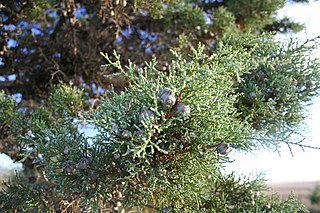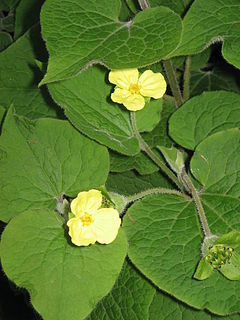
Cypress is a common name for various coniferous trees or shrubs of northern temperate regions that belong to the family Cupressaceae. The word cypress is derived from Old French cipres, which was imported from Latin cypressus, the latinisation of the Greek κυπάρισσος (kyparissos).

Dianchi Lake, also known as Lake Dian and Kunming Lake, is a large lake located on the Yunnan-Guizhou Plateau close to Kunming, Yunnan, China. Its nickname is the "Sparkling Pearl Embedded in a Highland" and it was the model for the Kunming Lake in the Summer Palace in Beijing. Its name is the source of Yunnan's Chinese abbreviation 滇.

Ulmus castaneifoliaHemsley, the chestnut-leafed elm or multinerved elm, is a small deciduous tree found across much of China in broadleaved forests at elevations of 500–1,600 metres (1,600–5,200 ft).

Ulmus szechuanicaFang, known as the Szechuan (Sichuan), or red-fruited, elm, is a small to medium deciduous Chinese tree found along the Yangtze river through the provinces of Sichuan, Jiangxi, Anhui, and Jiangsu.

Cupressus torulosa, commonly known as the Himalayan cypress or Bhutan cypress, is a species of cypress tree native to the mountainous northern regions of the Indian subcontinent, primarily the Himalayas.

A species that is extinct in the wild (EW) is one that has been categorized by the International Union for Conservation of Nature as known only by living members kept in captivity or as a naturalized population outside its historic range due to massive habitat loss.

Trachycarpus nana is a species of flowering plant in the family Arecaceae. It is found only in China. Its natural habitat is subtropical or tropical moist lowland forests. It is threatened by habitat loss.
Adiantum fengianum is a species of maidenhair fern endemic to China. Its natural habitat is temperate forests. It is threatened by habitat loss.

Helicia is a genus of 110 species of trees and shrubs, constituting part of the plant family Proteaceae. They grow naturally in rainforests throughout tropical South and Southeast Asia, including India, Sri Lanka, Indochina, Peninsular Malaysia to New Guinea and as far south as New South Wales.
Helicia shweliensis is a species of plant in the family Proteaceae. It is endemic to China, where it is confined to Yunnan. It is threatened by habitat loss. The causes of habitat loss are attributed to a variety of factors, but the most prevalent factors include the destruction of forests in favor of constructing plantations for the production of cash crops.
Hopea shingkeng was a species of plant in the family Dipterocarpaceae. It was endemic to the eastern Himalaya region of India.
Disepalum plagioneurum is a species of plant in the Annonaceae family. It is found in China and northern Viet Nam.
Richella hainanensis is a species of plant in the Annonaceae family. It is endemic to China.

Saruma is a monotypic genus of flowering plants in the family Aristolochiaceae containing the single species Saruma henryi. It is endemic to China, where it occurs in Gansu, Guizhou, Hubei, Jiangxi, Shaanxi, and Sichuan.
Aleuritopteris albofusca is a species of fern in the family Pteridaceae. It is endemic to China, including Tibet. Its natural habitat is subtropical or tropical dry forests. It is threatened by habitat loss.
Merrilliopanax alpinus is a species of plant in the family Araliaceae. It is found in Tibet (China), Bhutan, northeast India, and Nepal.

Tabernaemontana pandacaqui, known as windmill bush and banana bush, is a species of plant in the dogbane family Apocynaceae.

Orchideae is a tribe of orchids in the subfamily Orchidoideae. It has been divided into two subtribes, Orchidinae and Habenariinae. The subtribe Orchidinae alone contains about 1,800 species. However, although some phylogenetic studies have established the monophyly of the subtribes, the generic boundaries are unclear, with many genera as traditionally circumscribed being paraphyletic or even polyphyletic. Species of genera such as Habenaria and Platanthera have been placed into both subtribes. A 2017 molecular phylogenetic study found that both subtribes did form clades, but did not formally recognize Habenariinae, because of missing genera and uncertainty over generic boundaries. The Asian species of Orchideae, in particular, have been subject to repeated changes of generic placement from 2012 onwards.
Calamus nambariensis is a species of flowering plant in the family Arecaceae. It is found in Burma, Laos, Vietnam, Thailand, Nepal, Bhutan, Bangladesh, the Assam region of India and the Yunnan region of China.
Tsaiorchis keiskeoides is a species of flowering plant in the family Orchidaceae, native to northern Vietnam.











